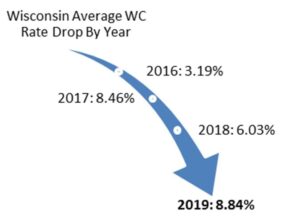Navigating the Future: A Deep Dive into P&C Insurance Industry Trends

The insurance industry, particularly Property and Casualty (P&C) insurance, has embarked on an exhilarating journey of transformation. No longer confined to traditional practices, the P&C insurance landscape is now a playground of innovation, disruption, and reinvention. As a player in this dynamic field, keeping your finger on the pulse of trends is not just advisable; it’s imperative.
The P&C insurance industry has always been one of adaptation. Throughout its history, it has weathered storms, both metaphorical and literal, to provide protection and peace of mind to individuals and businesses.
But today, the forces shaping the industry’s trajectory are more powerful and profound than ever before. Technological advancements, shifting customer expectations, regulatory shifts, emerging risk landscapes, and market consolidation are rewriting the rules of engagement.
Here, we embark on a deep dive into these insurance industry trends, unraveling their significance, and uncovering how players like InsuredMine are poised to reshape the industry landscape.
Technological Disruption
In the heart of the global insurance industry, a technological revolution is unfolding, reshaping the very foundations of how insurance carriers operate.
From cutting-edge innovations in insurtech to the integration of AI, blockchain, and IoT, the landscape is evolving at an unprecedented pace, presenting both challenges and opportunities that demand a closer look.
Insurtech Innovations
In the technologically charged world, innovation is the currency of growth. Enter Insurtech, a potent cocktail of insurance and technology that has given rise to groundbreaking solutions. It’s the space where creativity meets practicality, where digital solutions are not just ideas on paper but tangible tools that redefine how the industry operates.
AI and Machine Learning in Underwriting
AI-powered algorithms now crunch colossal datasets to unveil nuanced insights into risk assessment. This seismic shift improves accuracy and expedites decision-making, bolstering the underwriting process like never before.
A research study conducted by McKinsey & Company has revealed that AI-driven underwriting can enhance underwriting efficiency while simultaneously reducing underwriting expenses. These statistics illuminate the potential of AI to reshape the insurance landscape, not just as a technological novelty but as a strategic imperative.
Blockchain for Claims Management
Blockchain, the disruptor of industries, makes its grand entrance into claims management. It’s the antidote to opaque processes, offering transparency and trust to claimants and insurers alike. Imagine a world where claims are processed seamlessly, efficiently, and without friction.
It is known that blockchain technology in insurance can expedite claims processing by automating manual processes, enhancing data security, and reducing fraud. The decentralized and tamper-resistant nature of blockchain ensures that claims information is securely and transparently accessible to all stakeholders, eliminating delays and disputes.
IoT Impact on Risk Assessment
IoT, the symphony of interconnected devices, has composed a new tune for risk assessment. From smart sensors to wearables, real-time data from these devices paints a vivid picture of risk profiles. The result? Customized policies that resonate with the evolving lifestyles of policyholders.
According to a report by GlobalNewswire, the IoT insurance market is projected to grow from $45.2.2 billion in 2023 to $70.2 billion by 2028 at a CAGR of 9.21%. This exponential growth is indicative of the profound impact IoT is having on the insurance landscape, enabling insurers to refine their offerings and tailor coverage to individual needs.
Digitization of Customer Experience
As customers evolve, so must their experiences. Digitization takes center stage, enabling insurers to forge deeper connections. Mobile apps like InsuredMine allow you to connect with your customers and help them manage policies on the go, pay bills, send quote requests, receive information updates, and more. The key is empowerment through seamless digital touchpoints.
Mobile Apps for Policy Management
InsuredMine’s ace up the sleeve – mobile apps for policy management. A touch away from clients’ needs, allowing them to manage policies effortlessly, track claims, and explore coverage options. It’s not just service; it’s empowerment.
A recent survey by JD Power indicated that 74% of auto insurance customers have interacted with their insurers through a mobile app. This growing trend reflects the expectation of streamlined and convenient experiences that mobile apps can offer.
Chatbots and Virtual Agents
The future of customer service? Enter chatbots and virtual agents. These AI-powered companions offer instant support, guidance, and information, creating a frictionless customer journey. At InsuredMine, we know the power of a friendly chat that’s available 24/7.
Big Data Analytics for Personalized Offerings
Big data isn’t just big; it’s impactful. With data analytics, insurers can craft personalized offerings that resonate with individual needs. InsuredMine, with its integrated platform, takes data and transforms it into tailor-made solutions that customers can’t resist.
The significance of data-driven personalization is underscored by a study from Epsilon, revealing that 80% of consumers are more likely to make a purchase when brands offer personalized experiences. This preference for tailored offerings extends to the insurance sphere, where policyholders seek coverage that aligns with their unique circumstances.
InsuredMine leverages the power of data analytics to elevate the customer experience. By analyzing policyholder behaviors, preferences, and historical data, the platform enables insurers to craft offerings that resonate. This not only boosts customer engagement but also enhances the likelihood of policyholder retention.
Learn More About InsuredMine Today!
Regulatory Developments
Amidst the ever-shifting tides of the insurance sector, the regulatory landscape stands as a steady force, exerting its influence on every facet of the industry. As regulations evolve, compliance requirements transform, impacting market dynamics and ushering in a new era of sustainability and responsibility.
Changes in Compliance Requirements
Regulations are the fabric that holds the industry together. They’re also dynamic, evolving with the times. Staying compliant isn’t just about following rules; it’s about embracing agility and innovation while adhering to the latest mandates.
The insurance industry operates in a landscape heavily influenced by regulations and compliance. For instance, the implementation of the General Data Protection Regulation (GDPR) in the European Union has ushered in a new era of data protection, demanding that insurers handle policyholders’ data with the utmost care.
Impact of Regulatory Evolution on Market Dynamics
Regulatory shifts aren’t just constraints; they’re catalysts for change. They shape market dynamics, encouraging new avenues and refining existing ones. Adapting to these shifts is the hallmark of a forward-looking insurer.
One such example is the evolution of the insurance industry in response to climate change. Regulatory bodies are placing increased emphasis on insurers to adopt sustainable practices and incorporate climate risk assessments into their operations.
Sustainability and ESG Initiatives in P&C Insurance
Environmental, Social, and Governance (ESG) considerations are no longer just buzzwords; they’re fundamental drivers of the business models. Insurers embracing sustainability aren’t just making a statement; they’re securing a resilient future.
Research from McKinsey highlights that sustainable insurers outperform their peers across key metrics such as return on equity and growth. This underlines the financial and strategic benefits of incorporating ESG initiatives into insurance operations.
Shifting Customer Expectations
In the age of customer empowerment, the insurance industry is witnessing a seismic shift in what policyholders demand from their coverage providers.
From personalized policies that cater to individual needs to a heightened emphasis on transparency and seamless claims processing, the era of customer-centricity is redefining the very essence of insurance interactions.
Demand for Customized Policies
One-size-fits-all policies? Not anymore. Customers demand tailor-made solutions that align with their unique needs. The ability to offer customized policies isn’t just a perk; it’s a competitive advantage.
The rise of insurtech and digital platforms has ushered in an era of personalized insurance. Customers now expect policies that cater to their specific circumstances, preferences, and aspirations.
InsuredMine champions the cause of customized policies through the platform’s analytics capabilities. By analyzing policyholder data, insurers can identify trends, preferences, and behaviors that inform the creation of personalized coverage options. This not only enhances customer satisfaction but also boosts cross-selling and upselling opportunities.
Learn More About InsuredMine Today!
Transparency and Trust Building
In a world of skepticism, trust is the holy grail. Transparency in pricing, terms, and conditions fosters trust, solidifying customer relationships that withstand the test of time.
The Edelman Trust Barometer reveals that 81% of consumers consider trust in a brand as a deal-breaker or deciding factor when making purchasing decisions. This underscores the paramount importance of trust in fostering customer loyalty.
Customer-Centric Service in Claims Processing
Claims – the moment of truth for insurers. Swift, empathetic, and customer-centric claims processing isn’t just a goal; it’s a gold standard. InsuredMine’s platform streamlines the process, ensuring that the customer experience remains paramount.
Emerging Risk Landscape
As the world grapples with unprecedented challenges, the insurance industry is thrust into an evolving landscape of risks that demand fresh perspectives and innovative solutions.
From climate change-induced catastrophes to the growing specter of cybersecurity threats, the emerging risk landscape calls for a profound understanding of the dynamic forces that shape insurance paradigms.
Climate Change and Catastrophic Events
The world is changing, and so are the risks. Climate change and catastrophic events demand new approaches to risk assessment, coverage, and response. Insurers at the forefront of this adaptation are poised for resilience.
Research from the Intergovernmental Panel on Climate Change (IPCC) warns that without substantial mitigation efforts, global warming could reach 1.5°C above pre-industrial levels as early as 2030. This looming reality underscores the need for insurers to integrate a net zero economy and climate change considerations into their operations.
Cybersecurity Threats and Coverage
The digital age comes with its perils – cybersecurity threats being paramount. As cyber risk evolves, so should coverage. Insurers must stay ahead of these threats, ensuring that policyholders are shielded from the digital storm.
A report by Cybersecurity Ventures predicts that cybercrime could cost the world $10.5 trillion annually by 2025. This staggering projection underscores the imperative for insurers to offer comprehensive cyber insurance coverage that aligns with the evolving threat landscape.
Pandemic Preparedness and Response
The recent pandemic was a stark reminder of the unpredictable nature of risks. Insurers now need to incorporate pandemic preparedness into their strategies, offering coverage that provides peace of mind in uncertain times.
The COVID-19 pandemic triggered an upheaval in the insurance industry, raising questions about coverage for pandemics and communicable diseases. As businesses grappled with disruptions, the insurance landscape witnessed a surge in claims and policyholder inquiries related to pandemic-related losses.
Market Consolidation and Competition
Amid ever-evolving market dynamics, the insurance sector is experiencing a phenomenon that’s reshaping the competitive landscape – market consolidation.
Mergers, acquisitions, and the rise of new entrants are redefining the rules of engagement, challenging insurers to adapt, innovate, and strategically position themselves in a landscape marked by fierce competition and transformative alliances.
Mergers and Acquisitions in P&C Insurance
Consolidation is the new buzzword. Mergers and acquisitions reshape the competitive landscape, unlocking synergies and strengthening market presence. Adaptability is key in this landscape of shifting alliances.
Research by Deloitte reveals that the insurance industry witnessed a significant uptick in M&A activity in recent years, driven by factors such as the pursuit of growth, technological innovation, and diversification.
Rise of New Market Entrants
The insurance arena is welcoming new players – agile, tech-savvy, and disruptive. These entrants redefine norms, forcing established players to reinvent strategies, adopt new technologies, and elevate customer experiences.
The rise of insurtech startups and digital insurance platforms is emblematic of the changing dynamics in the insurance industry. These newcomers bring fresh perspectives, innovative technologies, and customer-centric approaches that challenge traditional norms.
Strategies for Sustaining Competitiveness
Competition is fierce, but so is innovation. Staying competitive involves a blend of tech adoption, customer-centricity, and strategic collaborations. It’s not just about survival; it’s about thriving in a sea of possibilities.
A report by EY emphasizes that to remain competitive, insurers need to pivot from a product-centric to a customer-centric approach. This shift is driven by customers’ growing demand for seamless, personalized experiences.
InsuredMine empowers insurers to embrace this customer-centric ethos. Our platform’s advanced analytics capabilities provide insights into policyholder behaviors, preferences, and needs, enabling insurers to tailor their offerings. This personalized approach not only fosters customer loyalty but also positions insurers as partners invested in their policyholders’ success.
Learn More About InsuredMine Today!
Data-Driven Decision Making
In an era where data holds unprecedented power, the insurance industry is at the cusp of a transformation that hinges on the art of data-driven decision-making.
From predictive modeling that enhances pricing strategies to leveraging analytics for risk assessment, insurers are navigating uncharted waters, harnessing data’s potential to drive precision, insights, and strategic excellence.
Leveraging Data Analytics for Risk Assessment
Data isn’t just information; it’s intelligence. Insurers that harness data analytics gain insights that redefine risk assessment. With tools like predictive modeling, they can proactively navigate the ever-evolving landscape of risks.
InsuredMine elevates data-driven decision-making through its robust analytics engine. By processing vast datasets, InsuredMine enables insurers to assess risks with greater accuracy, identify emerging trends, and develop strategies that mitigate potential challenges. This not only enhances underwriting precision but also positions insurers as proactive navigators of risks.
Predictive Modeling in Pricing Strategies
Pricing isn’t a shot in the dark; it’s a calculated science. Predictive modeling uses historical data to project future trends, enabling insurers to price policies with precision, and balancing affordability and profitability.
Research from the Society of Actuaries highlights that insurers consider predictive modeling as a top priority for their organizations. This reflects the growing recognition of predictive modeling’s potential to optimize pricing and enhance decision-making.
Using AI for Fraud Detection
Fraud detection isn’t just about vigilance; it’s about smart detection. AI analyzes patterns, identifies anomalies, and flags potential fraud with unmatched accuracy, safeguarding insurers and policyholders alike.
Workforce Transformation
The digital age isn’t just redefining how insurance is conducted; it’s also transforming the very fabric of the industry’s workforce. The evolution of roles, the embrace of remote work, and the imperative of upskilling are shaping a new era where technological literacy and adaptability are the cornerstones of success.
Upskilling in the Digital Era
Technology reshapes industries and careers. Upskilling isn’t just a choice; it’s a necessity. Insurers must invest in their workforce, ensuring they possess the digital prowess to navigate the tech-driven future.
Research from the World Economic Forum highlights the urgency of upskilling, revealing that employees will require significant reskilling. This underscores the seismic shift in skill demands driven by technological advancements.
Remote Work and its Long-term Implications
Remote work isn’t just a stopgap; it’s a paradigm shift. Insurers must adapt their operations, redefine collaboration, and leverage technology to facilitate seamless remote work for a more agile future.
A survey by Gartner reveals that 82% of company leaders plan to allow remote work in some form, even beyond the pandemic. This reflects the realization that remote work offers benefits in terms of flexibility, talent acquisition, and operational resilience.
Talent Retention Strategies
Talent isn’t just an asset; it’s the heart of innovation. Insurers must cultivate an environment that nurtures talent, offering growth opportunities, flexibility, and a sense of purpose.
Research by Mercer reveals that 56% of employees would consider leaving their current job for one with more flexible work arrangements. This underscores the importance of talent retention strategies that prioritize work-life balance and career growth.
Product Innovation
Innovation isn’t just a buzzword; it’s the heartbeat of the insurance industry’s future. The canvas of insurance products is expanding, with parametric solutions and microinsurance leading the charge.
From catering to niche needs to fostering partnerships that enhance offerings, insurers are embracing a paradigm shift where innovation isn’t just a strategy – it’s a mindset.
Parametric Insurance Solutions
Parametric insurance isn’t traditional; it’s revolutionary. It pays out based on predefined triggers, reducing claims processing time and ensuring swift assistance when it’s needed most.
The appeal of parametric insurance lies in its simplicity and speed. Unlike traditional claims processes that involve complex assessments, parametric insurance payouts are triggered by specific events, such as earthquakes or weather patterns.
Microinsurance and Market Expansion
Inclusion is the essence of microinsurance. It caters to the underserved, opening new avenues for market expansion while fulfilling a social responsibility.
Research by the International Labor Organization reveals that 2 billion adults globally are excluded from the formal financial system, underscoring the vast potential of microinsurance to bridge this gap.
Ecosystem Partnerships for Enhanced Offerings
No one operates in isolation. Ecosystem partnerships bridge gaps, offering customers a holistic experience. InsuredMine’s comprehensive CRM platform integrates seamlessly, transforming collaboration into a competitive advantage.
Research from Accenture highlights that insurance executives believe ecosystems are the key to their organization’s future success. This reflects the growing recognition of the role that partnerships play in enriching insurance offerings.
Claims Efficiency
The journey from claim initiation to resolution has undergone a revolution, propelled by automation, streamlined processes, and a commitment to delivering swift, empathetic experiences.
The age-old narrative of cumbersome claims is being rewritten, as insurers leverage technology to ensure that policyholders’ moments of need are met with efficiency, transparency, and customer-centricity.
Claims Automation and Speed
In the era of instant gratification, delayed claims are a relic of the past. Claims automation streamlines the process, ensuring that policyholders receive prompt assistance when they need it most.
The appeal of claims automation lies in its ability to expedite the claims process while minimizing human errors and bottlenecks. With automated workflows and AI-driven assessments, insurers can provide swift and efficient claims resolution.
InsuredMine champions the cause of claims efficiency through the platform’s automation capabilities. By streamlining claims workflows, insurers can ensure that policyholders’ experiences are characterized by speed and accuracy. This not only enhances customer satisfaction but also solidifies insurers’ reputation as providers of seamless solutions.
Learn More About InsuredMine Today!
Streamlined Processes for Customer Satisfaction
Complex processes are the bane of customer satisfaction. Streamlined claims processing not only reduces friction but also enhances customer loyalty, solidifying brand reputation.
Reducing Fraud in Claims
Fraud eats into profits and trust. Insurers are embracing advanced technologies to detect and prevent fraudulent claims, protecting their bottom line and maintaining the integrity of the industry.
As one of the most prominent insurance leaders, the Insurance Information Institute highlights the financial toll of insurance fraud, estimating that it costs the industry $30 billion annually.
Distribution Channels
Distribution isn’t just about getting policies into the hands of customers; it’s about crafting experiences that resonate in the digital age.
From direct online platforms to collaborative fintech partnerships, insurers are exploring an array of channels that cater to diverse preferences, reshaping how insurance reaches its audiences.
Online Platforms and Direct Sales
The digital era has birthed a new distribution model – online platforms and direct sales. With user-friendly interfaces, customers can explore, compare, and purchase policies with ease.
Collaborations with Fintechs
Fintech partnerships are a harmonious marriage of finance and technology. Collaborations leverage tech innovation to enhance insurance offerings, making them more accessible and relevant.
The rise of fintech startups and digital platforms has paved the way for collaborative innovation. Fintechs bring specialized expertise and tech-driven solutions that complement insurers’ offerings.
Importance of Traditional Agents
In the digital frenzy, the role of traditional agents remains vital. Their expertise, personal touch, and local knowledge offer a unique value proposition that can’t be replicated by algorithms.
Research by McKinsey reveals that insurance customers consider agents to be an important source of advice when purchasing insurance.
Pricing Challenges
Pricing in the insurance world isn’t just about numbers; it’s a delicate dance between affordability and profitability. The challenge lies in striking a harmonious balance, where policyholders find value while insurers maintain financial sustainability.
In a landscape marked by underwriting algorithms and regulatory scrutiny, the pricing narrative is undergoing a transformation that demands strategic prowess.
Balancing Affordability and Profitability
Pricing is a delicate equilibrium. Striking the balance between affordability for customers and profitability for insurers is a high-wire act that requires strategic precision.
Impact of Underwriting Algorithms
Underwriting algorithms redefine risk evaluation. While they enhance accuracy, they also pose ethical questions that insurers must address, ensuring fairness and transparency.
The rise of underwriting algorithms underscores the potential for more accurate and data-driven risk assessment. However, the adoption of these algorithms also raises concerns about bias, fairness, and transparency.
Regulatory Scrutiny on Pricing Practices
Regulators cast a discerning eye on pricing practices. Transparency, fairness, and adherence to regulatory guidelines are paramount, in shaping insurers’ pricing strategies.
The insurance industry operates in a regulatory landscape that emphasizes fairness and transparency in pricing. Regulatory bodies scrutinize pricing practices to ensure that policyholders are treated equitably and that pricing aligns with regulatory expectations.
Globalization and Market Opportunities
The insurance industry is no longer confined to geographical boundaries; it’s a global tapestry of opportunities that extend far beyond traditional markets.
Emerging economies, cross-border strategies, and cultural relevance are driving insurers to explore uncharted territories, tapping into growth prospects that demand adaptability and a keen understanding of diverse customer needs.
Growth Prospects in Emerging Markets
Emerging markets are the sunrise of growth. Insurers that tap into these markets unlock unprecedented opportunities, catering to the needs of a burgeoning middle class.
Also, the world is interconnected, and so are insurance needs. Cross-border expansion opens doors to new customers, new markets, and fresh perspectives that enrich insurers’ offerings.
Nevertheless, insurers must tailor their offerings to cater to cultural nuances, ensuring that policies align with the expectations and values of diverse audiences.
Industry Resilience
Resilience isn’t just about surviving disruptions; it’s about thriving in the face of challenges.
Recent disruptions, lessons in business continuity, and the imperative of adaptability are shaping a future where insurers must not only weather the storm but also emerge stronger, more agile, and better prepared to navigate the uncertainties that lie ahead.
Lessons from Recent Disruptions
Disruptions are lessons in resilience. Events like the pandemic reshape perspectives, accelerate digital transformation, and highlight the need for proactive risk management.
The COVID-19 pandemic was a wake-up call for the insurance industry, underscoring the importance of operational agility, digital readiness, and robust risk management strategies.
Overall, resilience is built on preparedness. Business continuity plans and new business models are a shield against disruptions, ensuring that insurers can navigate challenges while maintaining operational continuity.
Also, insurers must embrace adaptability, leveraging technology, data, and innovation to navigate uncertain environments, ensuring their relevance and longevity.
Summary
The P&C insurance landscape is in flux, a canvas painted with innovation, challenges, and opportunities. From technological disruption to shifting customer expectations, from emerging risk landscapes to market consolidation, insurers face a tapestry of dynamics that demand adaptability, innovation, and resilience.
In this landscape of transformation, InsuredMine emerges as a beacon of empowerment for insurers. Our comprehensive insurance CRM platform equips insurers with the tools to navigate the complexities of the industry, from data-driven decision-making to customer-centric experiences, from claims efficiency to cross-border expansion.
Ready to elevate your insurance operations to new heights? Experience the power of InsuredMine’s comprehensive insurance CRM platform firsthand.
Learn More About InsuredMine Today!



